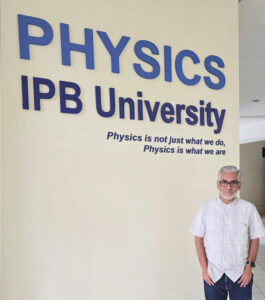Celebrating World Quantum Day: Living Organisms and Quantum Entanglement
 On April 14 2025, the world Celebrating World Quantum Day. The establishment of 2025 as an international quantum year is also based on the historical fact that the matrix mechanics model was proposed for the first time by German theoretical physicist, Werner Heisenberg, which later became one of the main pillars of quantum mechanics known to people today. While the selection of April 14 refers to the number of Planck’s constant (h) in electron-Volt (eV) energy units of 4.14×10-15 eVs.
On April 14 2025, the world Celebrating World Quantum Day. The establishment of 2025 as an international quantum year is also based on the historical fact that the matrix mechanics model was proposed for the first time by German theoretical physicist, Werner Heisenberg, which later became one of the main pillars of quantum mechanics known to people today. While the selection of April 14 refers to the number of Planck’s constant (h) in electron-Volt (eV) energy units of 4.14×10-15 eVs.
In the past century, the understanding of physics based on quantum theory of phenomena at the microscopic scale, ranging from (sub-)atomic to molecular sizes, has resulted in a wide variety of advanced technological applications that people can utilise today. Smart mobile phones or smartphones are clear evidence of the contribution of physics, especially quantum physics.
There are many phenomena at the microscopic scale that for everyday experience is something that is counterintuitive or in other words cannot be understood. The phenomenon of Heisenberg’s uncertainty which states that an observer cannot simultaneously measure the exact position and speed of a particle, such as an electron for example, simultaneously is the first example of strangeness in the quantum world.
In everyday experience, if we know with certainty the position of a ball for example, then by knowing the external conditions that affect it when it is kicked, physics in addition to knowing with certainty its condition, can also be determined with certainty where the ball will lead. This is not the case for a tiny particle such as an electron. Where the electron will go cannot be known with certainty, and only the probability of where it will go can be predicted.
Another counterintuitive phenomenon is related to measurement results. Two particles that are identical to each other and are under the influence of the same environment when measurements are made of their respective conditions can give different results. Even repeated measurements of the condition of a particle under the influence of the same environment can be different.
This phenomenon forces theoretical physicists to formulate the principle of superposition of quantum states which states that before a measurement is made, a tiny particle can be in several states at once and when a measurement is made it will be in one of these states.
The phenomenon of superposition of quantum states is the sum of all possible states or conditions in turn raises questions about reality in the quantum world which is still a mystery. Do electrons exist before and after observation? This is a fundamental question that is not easy to answer.
Another counterintuitive phenomenon that is even more far-fetched and seems to violate certain principles in physics is the phenomenon of quantum entanglement. Tiny particles, such as electrons or atoms, have a property that one cannot understand using concepts known at the macroscopic scale. This property is commonly known as spin, which can be in both spin-up and spin-down states for small particles such as electrons.
In general, particle spin refers to the macroscopic phenomenon commonly found in rotating objects. However, given the tiny size of, for example, an electron, and given the observations made, it is impossible to say that the electron is rotating. This people are forced to simply accept the fact of the existence of spin properties without understanding what it really is.
In the phenomenon of quantum entanglement, it is shown that two identical electrons or atoms that differ very far in position can be correlated with each other at the same time simultaneously. Suppose electron A is measured to have spin up, then it can be ascertained that its twin electron B which is very far apart is in a state of spin down.
This phenomenon has led to tremendous confusion as to how they communicate with each other. Theoretical physicists have offered various speculations to explain it, including theorising that the two electrons are connected through a wormhole to each other. A speculation that seems difficult to prove observationally. Nevertheless, this phenomenon of quantum entanglement has enabled the birth of technologies whose utilisation can be in the form of quantum cryptography technology and as a basic element in quantum information and quantum computing systems. These quantum technologies are the main key in mastering the future.
Recently, in a release on the website of the European Research Centre for Elementary Particle Physics or CERN in Geneva, Switzerland (https://home.cern/news/news/
If the provisional conclusion of this observation is correct, it should be suspected that quantum entanglement is actually not only experienced by flocks of goats, but also by other living organisms, such as birds, fish or bacteria, or even between humans.
The phenomenon of quantum entanglement between living organisms will certainly be a very important fact to ponder, besides of course being utilised. That in fact every living organism is correlated with each other certainly has profound implications for the way people view all living organisms. Will its utilisation through the application of technology, whatever form it takes, be able to ensure the sustainability of life on earth? Only time will tell. (IAAS/NRA)
By: Prof Husin Alatas
Professor of Theoretical Physics, IPB University
Department of Physics, Faculty of Mathematics and Natural Sciences



